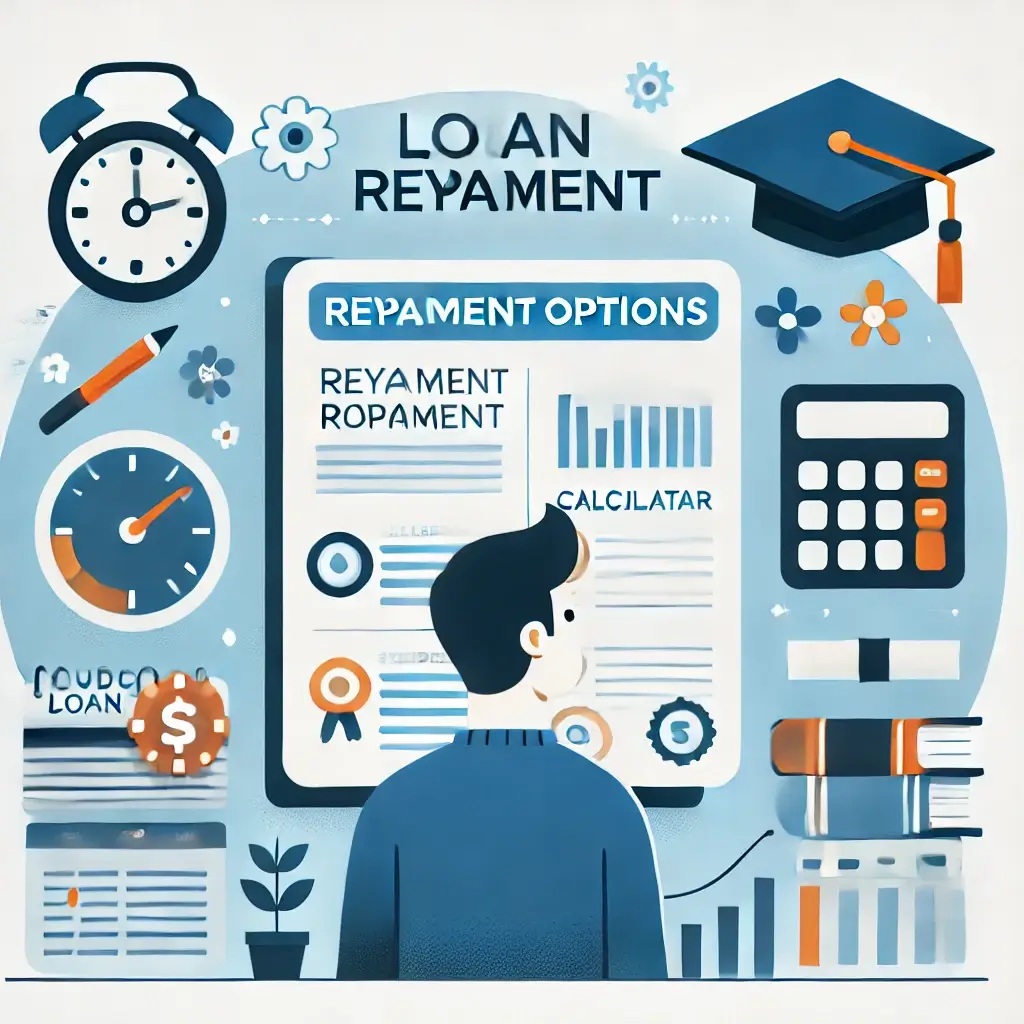Choosing the right Student Loan Repayment Options is crucial for managing your debt effectively and reducing financial stress. With multiple repayment plans available for both federal and private student loans, selecting the best option can make a significant difference in your monthly payments and how much you pay over the life of the loan. In this guide, we’ll explore the various repayment plans, their benefits, and how to decide which one suits your financial situation.
1. Standard Repayment Plan
The Standard Repayment Plan is the default option for most federal student loans. Payments are fixed over a 10-year period, which ensures that you pay off your loan quickly and with less interest.
1.1 How It Works
- Fixed monthly payments based on the total loan amount.
- The loan term is 10 years for most loans.
- Payments stay the same throughout the repayment period.
1.2 Benefits
- You’ll pay less interest over time since the loan term is shorter.
- It’s a simple, straightforward repayment plan.
1.3 Best For
Borrowers who can afford higher monthly payments and want to pay off their debt quickly.
2. Graduated Repayment Plan
The Graduated Repayment Plan starts with lower payments that increase every two years. This plan allows you to ease into repayment, with the assumption that your income will grow over time.
2.1 How It Works
- Payments start lower and gradually increase.
- The loan term is 10 years (up to 30 years for consolidated loans).
- Payments increase every two years.
2.2 Benefits
- Lower payments at the beginning make it easier to manage early in your career.
- Payments increase with your expected income growth.
2.3 Best For
Borrowers who expect their income to increase steadily, such as recent graduates entering the workforce.
3. Extended Repayment Plan
The Extended Repayment Plan lengthens the loan term to 25 years, reducing monthly payments but increasing the total interest paid over time.
3.1 How It Works
- Fixed or graduated payments over 25 years.
- Monthly payments are lower than the Standard Plan, but you’ll pay more in interest.
3.2 Benefits
- Lower monthly payments make it easier to manage on a limited budget.
- Flexibility to choose between fixed or graduated payments.
3.3 Best For
Borrowers with larger loan balances who need more manageable monthly payments.
4. Income-Driven Repayment Plans
Income-Driven Repayment (IDR) Plans calculate your monthly payments based on your income and family size. These plans can make payments more affordable, but they extend the repayment period to 20 or 25 years.
4.1 Types of Income-Driven Repayment Plans
There are four main IDR plans, each with its formula for calculating payments and forgiveness terms:
- Income-Based Repayment (IBR): Payments are capped at 10% to 15% of discretionary income, with forgiveness after 20 or 25 years.
- Pay As You Earn (PAYE): Payments are 10% of discretionary income, with forgiveness after 20 years.
- Revised Pay As You Earn (REPAYE): Similar to PAYE, but offers forgiveness after 20 years for undergraduate loans and 25 years for graduate loans.
- Income-Contingent Repayment (ICR): Payments are the lesser of 20% of discretionary income or a fixed amount based on a 12-year repayment plan, with forgiveness after 25 years.
4.2 Benefits
- Monthly payments adjust to fit your income, making repayment more manageable.
- Any remaining balance after 20 or 25 years of qualifying payments is forgiven.
4.3 Best For
Borrowers with high loan balances and lower incomes who need affordable payments. IDR plans are especially beneficial for those working in public service who are pursuing loan forgiveness through Public Service Loan Forgiveness (PSLF).

5. Public Service Loan Forgiveness (PSLF)
PSLF is a program that forgives the remaining balance on federal Direct Loans after 120 qualifying payments while working full-time for a qualifying employer in public service.
5.1 How It Works
- You must make 120 qualifying payments under an income-driven repayment plan.
- You must work full-time for a government or nonprofit organization.
5.2 Benefits
- Complete forgiveness of your loan balance after 10 years of qualifying payments.
- Ideal for borrowers in public service jobs such as teaching, healthcare, and nonprofit work.
5.3 Best For
Borrowers who plan to work in public service can commit to 10 years of qualifying payments.
6. Refinancing Your Student Loans
Refinancing student loans is another repayment option, especially for borrowers with private loans. Refinancing involves taking out a new loan with a private lender to replace your existing loans, ideally at a lower interest rate.
6.1 How It Works
- You combine one or more federal or private loans into a new loan with a private lender.
- Interest rates may be lower depending on your credit score and income.
6.2 Benefits
- Potential for lower interest rates, reducing your total loan cost.
- Simplifies repayment by consolidating multiple loans into one.
6.3 Risks
- If you refinance federal loans, you lose access to federal benefits like income-driven repayment plans and loan forgiveness programs.
6.4 Best For
Borrowers with a stable income and good credit who want to lower their interest rate and don’t need federal loan protections.
7. Deferment and Forbearance
If you’re facing temporary financial hardship, deferment and forbearance can provide a break from payments. However, interest may continue to accrue on certain types of loans during this period.
7.1 How It Works
- Deferment: Temporarily suspends payments, typically without interest accruing on subsidized loans.
- Forbearance: Temporarily suspends payments, but interest continues to accrue on all loans.
7.2 Benefits
- Provides financial relief during difficult times, such as unemployment or medical issues.
7.3 Best For
Borrowers facing temporary financial difficulties need a short-term solution to stay afloat.
8. Frequently Asked Questions About Student Loan Repayment Options
8.1 Can I Switch Repayment Plans Later?
Yes, federal student loan borrowers can switch repayment plans at any time. This flexibility allows you to adjust your repayment strategy if your financial situation changes.
8.2 Is It Better to Refinance or Stick with Federal Loans?
It depends. Refinancing can lower your interest rate, but it comes with the loss of federal loan benefits like income-driven repayment and forgiveness options. If you value those benefits, sticking with federal loans may be a better option.
8.3 How Do I Know Which Repayment Plan Is Best?
Your repayment plan should fit your current income, financial goals, and loan balance. If you can afford higher payments, the Standard Plan helps you pay off debt faster. If your income is lower, an income-driven plan may be a better fit.
Conclusion on Student Loan Repayment Options
Choosing the right Student Loan Repayment Options is a critical step in managing your debt and working toward financial freedom. Whether you opt for a standard plan, income-driven repayment, or refinancing, understanding your options will help you make the best decision for your financial future. By assessing your income, career plans, and loan balance, you can select a repayment strategy that fits your needs and helps you achieve your goals.
